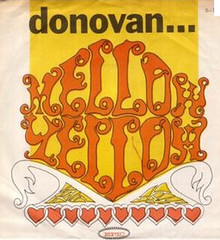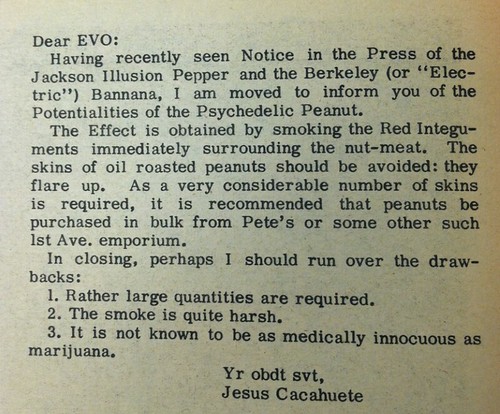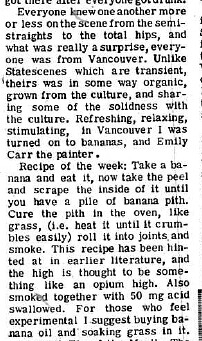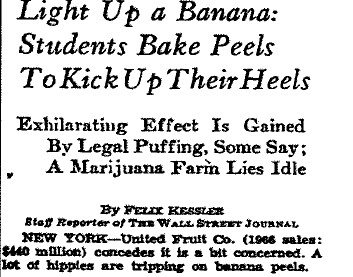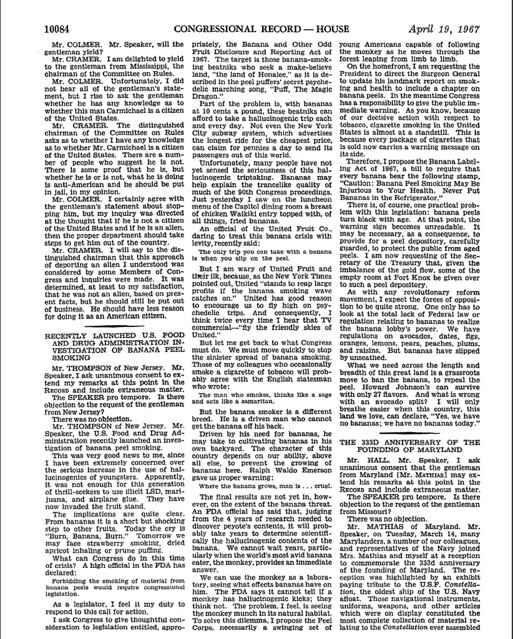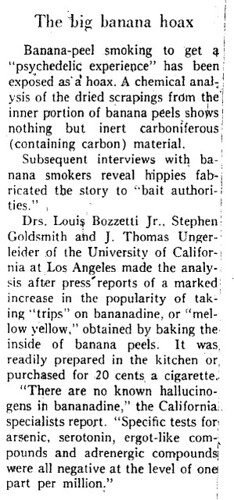Sixties survivors often snicker when reminded of the Great Banana-Peel Smoking Hoax. They remember the hours spent laboriously scraping the inside of banana peels, boiling the unappetizing residue obtained, then drying the remains in their ovens before finally rolling a joint in search of the promised high from the fictional psychoactive substance dubbed Bananadine.
Nearly a half-century later, conflicting accounts still circulate as to how the craze got started and which underground paper was first to report it. One version, often repeated by Paul Krassner, the iconic publisher of The Realist, puts the launch in the offices of The East Village Other on Avenue A. In other accounts, it starts on the West Coast. So which was it?
During a recent conversation with The Local, Mr. Krassner repeated the version he offered both in his 1993 book, “Confessions of a Raving, Unconfined Nut” and in comments for a 2008 obituary of Walter Bowart in the Los Angeles Times.
Mr. Krassner describes a 1967 visit to EVO’s office — the Realist office was nearby — and recalls Mr. Bowart, Allen Katzman and Dean Latimer, one of EVO’s lead writers, discussing “The Morning of the Magicians,” the influential occult book that touted LSD usage and popularized a number of conspiracy theories and esoteric notions.
Mr. Krassner said that on learning that LSD releases serotonin in the brain, the EVO-niks began to wonder if the chemical might also be found in non-chemical substances. Bananas contain serotonin. Mr. Krassner recalled a story in the Other about the special properties of bananas that even offered a detailed recipe for how to derive the substance from the fruit. Then, in the Krassner version (also the version relayed in the Sept. 1978 issue of High Times), on came the frenzy: longhairs started buying bananas by the bunch-load to process and smoke. Local fruit markets could not keep bananas in stock.
But here’s the thing: The Local’s review of EVO issues from December 1966 through to the end of March 1967 finds just one mention of bananas. It’s in a letter to the editor published in the February 15-March 1, 1967 issue. The letter bears the signature Jesus Cacahuete (“Cacahuete” is Spanish for peanut. Hmmm . . . ) and refers to “the Berkeley (or Electric) Bannana [sic].” Mr. Cacahuete’s focus is not bananas but the psychedelic peanut, conveying the impression that banana smoking by that point already was a well-established trend.
With the words “Berkeley (Electric) Bannana [sic],” Mr. Cacahuete may have been referring, at least in part, to a lyric in the Donovan song, “Mellow Yellow“:
Electrical banana, is gonna be a sudden craze.
The hit single had been released in the U.K. a few months earlier and had its U.S. debut that February. (In the “Rolling Stone Encyclopedia of Rock n’ Roll” and in an interview with NME dated June 18, 2011, Donovan is quoted as saying that “mellow yellow” had nothing to do with banana smoke but referred to a banana-shaped vibrator then newly on the market. The phrase “mellow yellow,” NME points out for good literary measure, also appears in James Joyce’s “Ulysses” in a descriptive reference to the backside of Marion Bloom.
(Another pertinent factoid: Ed Sanders dismissed any suggestion that a 1963 reference to bananas and drugs in his mimeographed arts and culture magazine had anything whatsoever to do with the later craze. John McMillian elicited Mr. Sanders’s emphatic no when he pursued the question for his book on the underground press, “Smoking Typewriters.”)
It’s possible that Mr. Cacahuete meant to cite an article in the Berkeley Barb dated March 3, 1967. (This could or could not have predated the publication of EVO’s Feb. 15-March 3, 1967 issue. Issue timing and dating in the underground press, we find, were ever casual and inexact. So, in fact, the first published reference to the practice could have come from either paper.)
In the Barb piece, two brief paragraphs near the end of Ed Densen’s regular “Folk Scene” column (at right) note his encounter with banana high-making in Vancouver. He even provides a recipe. (Was this the story and recipe to which Mr. Krassner has so often referred? Or did he conflate his recollection with the smoked peanuts letter from Mr. Cacahuete? Hmm.)
Mr. Densen of the Barb, it turns out, was also the manager of the band Country Joe and the Fish. The band played the Kitsilano Theater in Vancouver in mid-February of that year, hence Mr. Densen’s northward visit. Country Joe McDonald’s website also describes the singer’s introduction to banana smoking and places it in Vancouver. The last concert at the Kitsilano was either on Feb. 16, 17 or 18, Mr. McDonald said in an email this week to our colleagues at Vancouver Observer, who generously pursued the matter at our request.
This timing coincides logically with Mr. Densen’s banana reference in his “Folk Scene” column in the Barb on March 3. That issue of the paper also includes a letter to the editor from a San Francisco shopper who did not give his or her name but reported unusual narcotics squad activity around the banana stand at a co-op on Telegraph Avenue:
And in the Barb’s March 10 issue, this drawing and letter to the editor appeared:
And on March 17, the Barb ran this pickup from the Oracle (note the Barb addendum from an unnamed local doctor):
And then came this Barb follow-up piece, signed “N.F.”, on March 24:
By contrast, in EVO, other than the letter to the editor that appeared in the Feb. 15-March 1 issue, the only banana mention appears nearly two months later, in the April 1-15, 1967 issue. There’s an ad for a San Francisco start-up, “Mellow Yellow” and then an off-handed mention in a column about an Easter Sunday Be-In. (Easter was March 26 in 1967.)
The mainstream press quickly seized on the story. By March 14 — in this case, the dating is precise — United Press International already had carried word of it, not as a pick-up from the underground papers of New York or Berkeley, but from the student newspaper of the University of Michigan at Ann Arbor. (It’s likely, as Mr. Krassner describes, that the Underground Press Syndicate had already indeed circulated those earlier mentions.) The UPI item describes banana smoking as an established trend by that point and reports that it “may have been kicked off by a recent article in the California underground newspaper, the Berkeley Barb.”
It also cites a spokesman for the Barb saying the craze began with an anonymous letter to the paper. (Could the spokesman’s reference be, by any chance, to Mr. Cacahuete’s letter published Feb. 15-March 1 in the East Village Other? Or does he mean the letter from the Berkeley shopper when Mr. Densen’s column appeared in the same issue and yet wasn’t mentioned? Hmm.)
By March 27, the New York Times reported that “beatniks and students were chanting, ‘Banana! Banana! Banana!’” at that Easter Sunday be-in in Central Park. The article describes a parade around Sheep Meadow during which one youth who sat on the shoulders of another carried a wooden banana that was two feet long. At a banana rally in Washington Square Park, someone mounted the statue of Alexander Lyman Holley to sing “calypso praise to the banana gods.”
By March 30, the Wall Street Journal had weighed in:
And by April 4, so had the government. The Food and Drug Administration announced an investigation into “the possible hallucinogenic effects of banana peels” by having scientists in their labs duplicate the process described in the underground press. They closely followed the recipe in processing thirty pounds of bananas in a series of tests to determine the effects of the chemical.
“We really don’t know what agent, if there is any, in the smoke produces the reported effect but we are investigating to see if it might be the methylated form of serotonin,” the FDA’s commissioner, Dr. James Goddard, said in announcing the investigation. In a telephone interview with The Times, Fred Garfield, the FDA’s deputy director, called the tests that began in mid-March “very complex.”
“Personally,” Mr. Garfield said at the time, “I’m not so sure that there is anything in bananas that would cause an hallucinogenic effect, as the kids claim.” Yet even if a euphoria-producing substance were found in banana peels, to forbid it would require an act of Congress “and I’m confident that such a law would never pass,” he told The Times.
This did not stop the craze. An April 7, 1967 piece in Time magazine noted the “dizzying speed” at which discoveries of the psychedelic revolution were being passed around through the underground press. A “Cosmic Love-In” in New York on May 2 attracted a Times reporter and one Harold Chizman, who offered a three-cent rebate on the bananas he was selling for 15 cents apiece if the buyer returned the peel. “Help a beatnik in his humble attempt at an honest living,” the sign he carried read, “Buy a banana.”
For three weeks the FDA monitored the apparatus it deployed to smoke the dried residue of banana peels. Its conclusions were reported in the Wall Street Journal of May 29, 1967: its analysis of the smoke derived from several recipes for dried banana peel and concentrated banana juice showed “no detectable quantities of known hallucinogens.”
On June 11, the Los Angeles Times devoted a long takeout to the phenomenon, titled, “The Great Banana Peel Experiment.” The piece describes a parallel investigation undertaken by United Fruit and led by the leading LSD researcher of the day, Dr. Sidney Cohen. In his pink house in Mandeville Canyon, Dr. Cohen’s wife and son spent three days and nights scraping and cooking some 150 pounds of bananas to produce 40 ounces of the substance needed for the study.
Dr. Cohen explained to the reporter that bananas not only contain serotonin but also norepinephrine, both chemicals found in human metabolisms. Neither is hallucinogenic, but hallucinogenic compounds can be produced with the addition of methyl groups, such as bufotenin. “Cohen theorized that possibly something strange does after all go up in banana smoke,” the reporter, Art Seidenbaum, wrote.
Yet in the end, Dr. Cohen’s trials on human subjects supported the government’s no-joy findings. As one of his test subject’s said, “If I had smoked this much pot, I’d be out of my mind. This isn’t anything.”
By April 19, Rep. Frank Thompson, a New Jersey Democrat, brought some levity to the House of Representatives by urging Congress “to move quickly to stop the spread of banana smoking,” with his facetious but impassioned introduction of a “Banana Labeling Act” that would require a sticker on banana skins warning of their danger, much in the way that cigarettes by then were being labeled.
Though the evidence had been processed and conclusions drawn, the trend did not entirely abate. In the summer of 1968, an EVO survey reported that 67 percent of its readers smoked grass and 19 percent had smoked bananas (but EVO did not say when – maybe most had tried it the previous year.) As late as 1970, William Powell’s “The Anarchist Cookbook” included a recipe for processing bananas and obtaining “musa sapientum Bananadine.”
Almost a year after the frenzy, the now-defunct magazine Science Digest reprised the whole affair in its February 1968 issue. In the item excerpted at right, it cited the study of three UCLA scientists, Drs. Louis Bozzetti Jr., Stephen Goldsmith and J. Thomas Ungerleider, whose analysis showed no known hallucinogens in bananadine. “Specific tests for arsenic, serotonin, ergot-like compounds and adrenergic compounds were all negative at the level of one part per million,” the scientists reported. And noting further how often the smoking took place under psychedelic lighting, they offered the suggestion that bananadine’s most active ingredient might well be “the setting.”
In yet another study, interviews with 50 subjects by a team of New York University scientists led them to conclude similarly that the effects of banana smoke were more psychological than drug-induced.
But let’s bring this back to Country Joe McDonald, who maintains with good chronological evidence that it really was he who popularized the practice. Right after Vancouver, on Feb. 19, he returned to Berkeley and played California Hall. He reports on his website, “We passed out 500 banana joints to the audience that night and told them, ‘It’s banana, it gets you high.’”
Charles Perry, in his 2005 book “The Haight Ashbury,” reports that the night after the Berkeley Barb’s March 3 piece appeared, Country Joe’s guitarist “announced the new legal trip from the stage, lit up a banana joint and passed a tray-full around.” Perry continues:
The idea spread like wildfire. The [San Francisco] Chronicle the next day put it on page one and reported that a Haight Street store window was displaying a “mellow yellow” recipe that called for boiling a whole blenderized banana. Jerry Rubin told the Chronicle that bananas “work every time.’ A buckskinned Berkeley acid guru who was coincidentally running for city council assured reporters that bananas “have been used in some cultures for centuries.”
(One snag: Scholars, however, date the San Francisco Chronicle’s first story at March 4, 1967 – the day after the Barb story — not Feb. 20, the day after the California Hall concert. We were unable to obtain a copy from microfilm in time for publication but will insert it when we can. Update: A copy of the piece, dated March 4, is below.)
Conclusion? Like all success, the Great Banana Smoking Hoax has many mothers. And, yet, as Mr. Seidenbaum of the Los Angeles Times concluded, “Whether it began by the Bay or in Greenwich Village or with a Donovan lyric doesn’t matter. The consequences were far-reaching, if not mind-expanding. A gigantic corporation was affected by obscure hippies grinding out powder and rumors. That’s part of the communications system we now live with — immediate folklore.”
Nicki Bertsch at NYU and John Jackson at USC helped research this story, as did our friends at the Vancouver Observer. For a more expansive treatment of the episode, please see the entire chapter devoted to it in John McMillian’s “Smoking Typewriters.” Mr. McMillian is moderating the panel Feb. 28 for the “Blowing Minds” exhibition opening at NYU.




